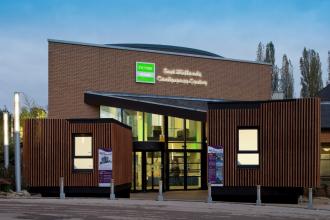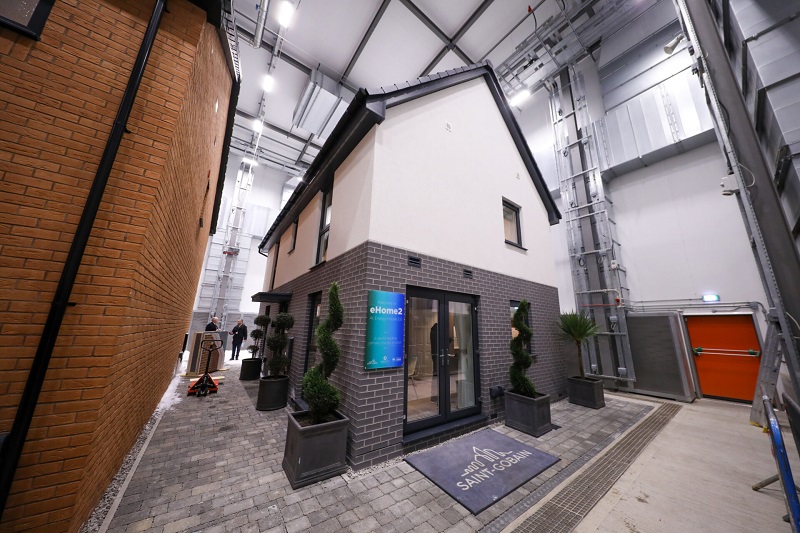Two timber clad pods made their debut at this year’s Passivhaus Conference in a live ‘Spot the Difference’ format never seen before.
Saint-Gobain joined forces with Church Lukas, Factory Homes and GB Building Solutions to create the two prefabricated student bedroom pods, one to Part L 2006 specifications and the other in accordance with Passivhaus principles.
Although they looked identical, in terms of thermal performance and efficiency the pods told a very different story. Student volunteers stayed in the bedrooms during the first evening of the conference, which took place from 7-8 November at The University of Nottingham, and energy consumption was closely monitored.
The results were shared at the final session and as the temperature in the pods stabilised, early readings showed an initial average energy consumption level of 180kWh/m² for the Part L 2006 pod, compared to just 50kWh/m² for the one constructed in accordance with Passivhaus principles. The pods have now being moved to the Energy Technologies Building, a specialist research centre at The University of Nottingham, where monitoring and testing will continue.
Made almost entirely from materials supplied by Saint-Gobain’s UK businesses, including Saint-Gobain Glassolutions, Saint-Gobain Isover, British Gypsum, Pasquill and International Timber, the pods were designed by Nottingham-based architectural practice Church Lukas, which has extensive experience of off-site construction and knowledge of sustainable student accommodation.
Products used in the construction of both modules included window units manufactured by Saint-Gobain Glassolutions in association with H Jarvis, British Gypsum’s Gyproc WallBoard, Saint-Gobain Isover’s Vario air-tightness and moisture management membrane, Glulam ring beams from Pasquill and planed timber batten cladding from International Timber. Insulation from Saint-Gobain Isover, including Timber Frame Batt 35, Spacesaver and Frame Façade slab, was also incorporated.
Double glazed casement windows with a u-value of 1.6 were used in the unit built to Part L 2006 specifications, while the insulation included 90mm Timber Frame Batt 35 and 50mm Frame Façade slab in the walls, 350mm Spacesaver in the roof and 150mm Spacesaver in the floor. However, the module constructed in accordance with Passivhaus principles featured triple glazed casement windows with a u-value of 0.8, along with thicker insulation. This included 200mm Timber Frame Batt 35 and 100mm Frame Façade slab in the walls, 550mm Spacesaver in the roof and 200mm Spacesaver and 50mm Frame Façade slab in the floor, inserted between I-beams and I-joists supplied by Pasquill.
The modules were manufactured by Factory Homes, a division of the UK’s largest holiday home producer Willerby Homes. Project coordination and installation was managed by GB Building Solutions, which is currently building its second Passivhaus development and is the only contractor in the world to have delivered a BREEAM Outstanding rated multi-residential scheme – a 1,026 bed student residential village at the University of Bradford.
The Saint-Gobain H.O.U.S.E (Home Optimising the Use of Solar Energy) was also a key attraction at the Passivhaus Conference. The modular property originally made its debut at Ecobuild 2010 before setting sail for Madrid to compete in the first international Solar Decathlon Europe competition, where it ranked high for its environmental credentials, coming a close second in the sustainability category
Designed by students from the University of Nottingham and constructed using materials supplied by Saint-Gobain, the H.O.U.S.E demonstrates how low energy architecture can lend itself to the mass market. Its L-shaped, modular design can be worked into terraces, rows or stacked as apartments, offering the chance to generate high densities in a master plan while still incorporating a private green space.
The Saint-Gobain H.O.U.S.E is now situated on Green Close at The University of Nottingham, where it is being reconstructed to Passivhaus standards in preparation for assessment by the Building Research Establishment’s Passivhaus Certification Scheme.
Lindsey Walker, strategic marketing leader for Saint-Gobain UK and Ireland, comments: “If we are going to tackle climate change and reduce our fuel consumption we need to be constructing low energy buildings today.
“Designing and building to Passivhaus standards offers a practical way to reduce COâ‚‚ emissions from the built environment and what the student pods and the Saint-Gobain H.O.U.S.E help to demonstrate is that energy efficient living can easily be achieved using products and systems that are commercially available today.”










